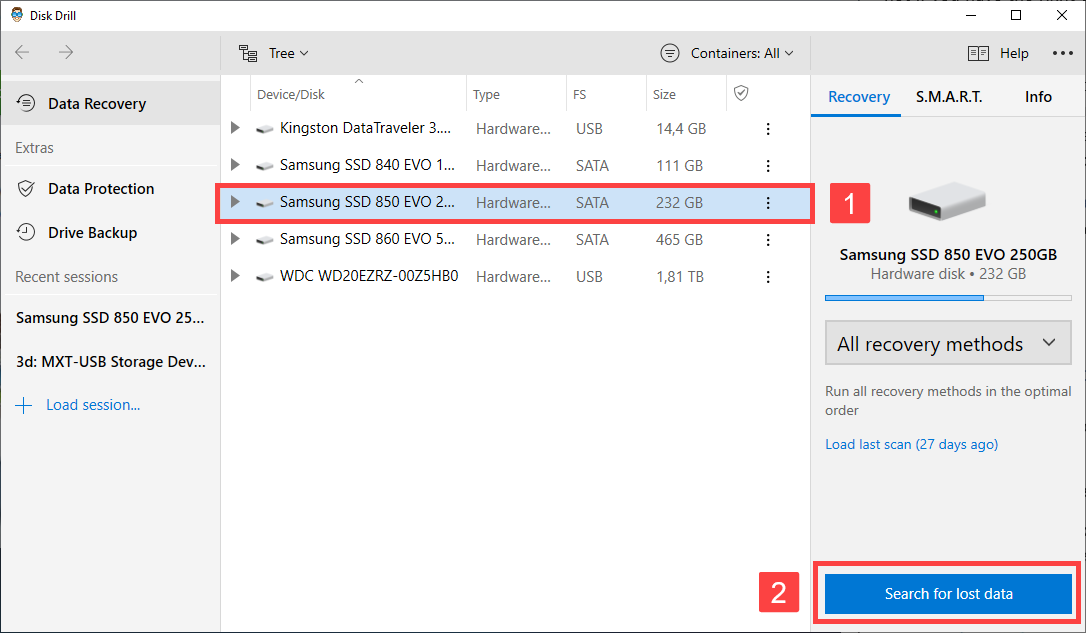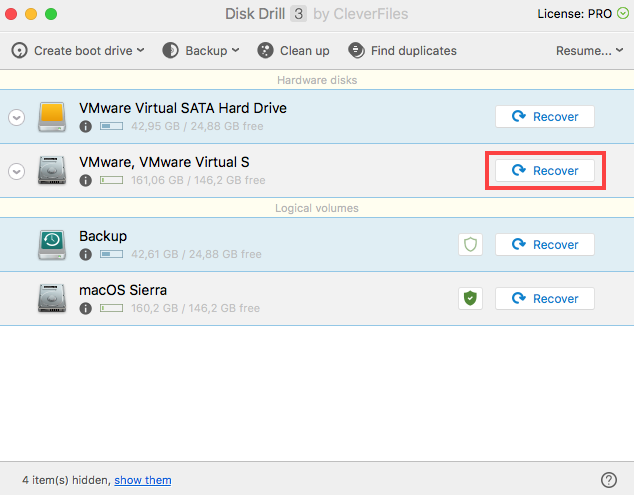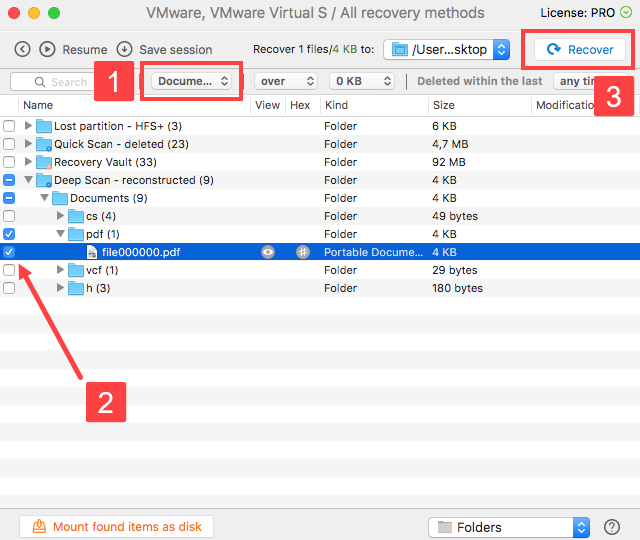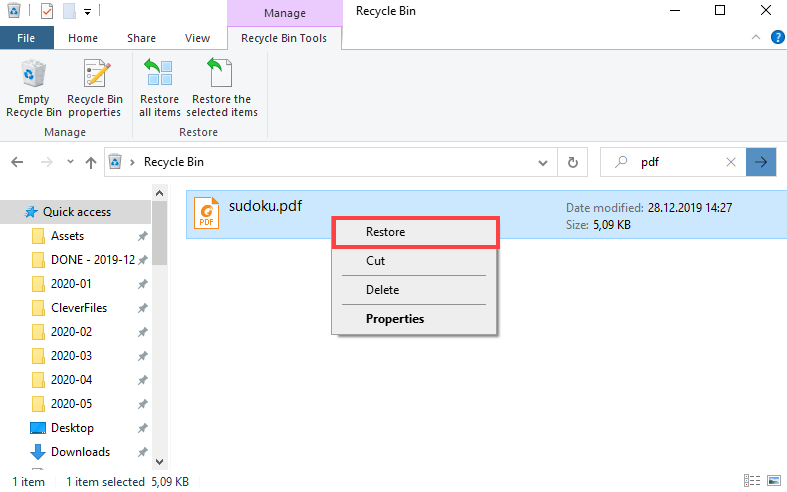
The PDF file format has become a de facto standard for transferring important documents thanks to its ability to preserve complex formatting across devices. But even though countless individuals and businesses rely on it every single day, not many people know how to recover deleted PDF documents.
The goal of this article is to shine a light on PDF recovery by providing detailed step-by-step instructions that anyone can follow with ease.
How to Find PDF Files on a Computer?
Just because your PDF files seem to be gone for good doesn’t mean they really are. Before you attempt to recover PDF files, you should first look for your PDF files in places where you wouldn’t normally expect them to be. The good news is that both Windows and Mac have a built-in search feature that lets you find all PDF files on your computer.
To find PDF files on Windows:
- Open File Explorer.
- Select any storage device where you expect your PDF files to be.
- Enter the following string in the search bar and hit Enter:
ext:.pdf

- Wait for File Explorer to finish searching for files with the .pdf file extension.
- Go through the results and look for your PDF files.
To find PDF files on Mac:
- Launch Finder.
- Enter “pdf” (without the quotation marks) in Finder’s search bar.
- Select Kinds: PDF Document.

- Wait for Finder to finish searching for files with the .pdf file extension.
- Go through the results and look for your PDF files.
Where Are PDF Files Stored on Windows and Mac?
On Windows and Mac PDF files are commonly stored in the Documents folder:
- Windows: C:\Users\username\Documents
- Mac: /DriveName/Users/username/Documents/
How to Recover a Deleted PDF File?
In most cases, it’s possible to restore PDF files that have been accidentally deleted, but you need to act quickly and begin the recovery process before the deleted PDF files get overwritten by new data. Let’s take a closer look at three different ways to perform deleted PDF file recovery.
Solution 1: Recover PDF Files using a PDF Recovery Tool
This solution we want to describe can help you restore even permanently deleted PDF files that are no longer in the Recycle Bin or Trash. We’re talking about PDF recovery tools, which are software applications whose purpose is to scour a storage device for deleted files and get them back in their original form.
One PDF recovery tool that makes the whole process incredibly easy and delivers fantastic results is Disk Drill, and it runs on both Windows and Mac.
To recover PDF files using Disk Drill for Windows:
- Download and launch Disk Drill for Windows.
- Select the storage device on which the PDF files were stored and click Search for lost data.

- Use the file format filters on the left to narrow down the scan results until you find the PDF file you’re looking for.
- Click the checkbox next to all PDF files you want to undelete and click the blue Recover button at the bottom.
- Specify the recovery folder and click OK.

To recover PDF files using Disk Drill for Mac:
- Download and launch Disk Drill for Mac.
- Click the Recover button next to the drive on which your PDF files were stored prior to deletion.

- Look inside the recovery folders and locate your PDF files using the preview feature.
- Select each PDF file you want to recover and click the Recover button.
- Specify where you want Disk Drill to recover the deleted files and click Choose.

Besides PDF files, Disk Drill can recover hundreds of other file formats, including all popular document file formats, such as DOC, DOCX, XLS, XLSX, PPT, PPTX, TXT, XML, TEX, ODT, ODS, ODP, NUMBERS, PAGES, and others.
Solution 2: Check Backups and Temporary Files
If you regularly back up your files, you’re in luck because you can simply restore all lost PDF files from a backup. Unfortunately, most users don’t back up their data on a regular basis, which means that this simple solution won’t work for them.
But before you try our second solution, you should look for your PDF files among temporary files:
- Windows: C:\Users\%UserName%\AppData\Roaming\Adobe\Acrobat\1X.0\AutoSave\
- Mac: Open the Terminal application and type: echo $TMPDIR
Just keep in mind that temporary files can have really strange names and even stranger file extensions, so don’t let that throw you off and try to open temporary files in your favorite PDF reader.
Solution 3: Restore PDF Files from the Recycle Bin or Trash
Both Windows and Mac have a special folder for deleted files, called the Recycle Bin and Trash, respectively. Restoring PDF files from the Recycle Bin and Trash is easy, but it’s unlikely that you’ll be able to use this method to get back PDF files that were stored on a USB flash drive or some other external storage device.
To restore PDF files from the Recycle Bin on Windows:
- Access the Recycle Bin by clicking on its desktop icon. You can also access the Recycle Bin by typing shell:RecycleBinFolder in the Run dialog box (Win + R).
- Highlight the PDF files you want to recover.
- Right-click on any highlighted PDF file and select the Restore option.

To restore PDF files from Trash on Mac:
- Open Trash by clicking on its icon, located on the right side or bottom of the Dock. If you don’t see the icon, you can also open Trash by entering the following command in a Terminal window:
open .trash
- Go through Trash and look for the PDF files you want to undelete. When you find them, select them by either pressing and holding the command key and then clicking the files or by holding the left mouse click and dragging the cursor around them.
- Right-click on any of the selected PDF files and select the Put Back option.

Tip: You can sometimes undo a PDF deletion using CTRL + Z on Windows or Command + Z on Mac. Because these two commands undo the previous action, they won’t help you restore PDF files that have been deleted a long time ago.
How to Restore a PDF to a Previous Version?
PDF recovery tools like Disk Drill can restore permanently deleted PDF files, but they can’t help you get back PDF files that have been overwritten. To restore an overwritten PDF file to a previous version, you need to recover an older snapshot using File History on Windows or Time Machine on Mac.
To restore a PDF to a previous version with File History on Windows
- Open Windows Explorer and right-click on the folder where the deleted PDF files were located.
- Select Restore previous versions.

- Select the most relevant File History backup and click the small arrow next to Open. Choose the Open in File History option.

- Select the PDF file you want to recover and click the green Recover button at the bottom of the preview window to recover it.

To restore a PDF to a previous version with Time Machine on Mac
- Open the folder that contained the deleted PDF files.
- Click the Time Machine icon located in the Menu Bar and choose Enter Time Machine.

- Find the PDF files you want to recover using the timeline on the right edge of the screen.
- Select the PDF file you want to recover and click Restore to restore the selected PDF file.

NOTE: The method won’t work if you hadn’t activated File History or Time Machine before you lost your PDF file.
How to Repair a Corrupted PDF File?
PDF files can become corrupted after a sudden loss of power, hardware malfunction, or malware attack. Corrupted PDF files are sometimes unreadable using PDF viewers like Adobe Reader, which display error messages like this one:
To repair a corrupted PDF file, you have two basic options:
- Online PDF repair tools: Online tools like iLovePDF or PDF2Go can quickly and easily repair damaged PDF files, but they come with a certain privacy risk because they require users to upload their PDF documents online.
- Desktop PDF repair tools: If you’re not ready to upload your PDF files online, you can use a desktop PDF repair tool like Sejda PDF Desktop or PDF Repair Toolbox to fix corrupted PDF files right on your computer.
Conclusion
It’s safe to say that the world depends on PDF files. Without them, businesses and organizations would find it difficult to share important documents, and individual users would deal with endless compatibility and formatting issues. However, PDF files are just as vulnerable to accidental deletion as other files, which is why it’s so important to know how to recover them.
FAQ
- Click Select PDF file and choose your corrupted PDF file. Alternatively, drag and drop it directly onto the page
- Click Repair PDF
- When it’s finished, click Download file
- Download, install and open Recovery Toolbox for PDF
- Select the PDF file you want to repair/recover
- Specify where the recovered file will be saved
- Choose the PDF file version
- Click Save file
- Download, install, and open Disk Drill. Make sure your Android device is connected to the computer via USB
- In Disk Drill, click on your device and click Search for lost data
- When Disk Drill has finished scanning, click Review found data
- Select the PDF files you want to recover by checking their box. Then, click Recover
- Specify a location for the files to be recovered to and press OK
- Right-click your PDF file and click Restore previous versions
- Select another version of your file (one dated before you saved it last)
- Click Restore
- Download, install, and open Disk Drill
- Select the drive that held the file, then click Search for lost data
- When the scan has finished, click Review found items and scan the list for the PDF
- Tick the PDF for recovery, then click Recover
- Choose the location for recovery, then click OK




